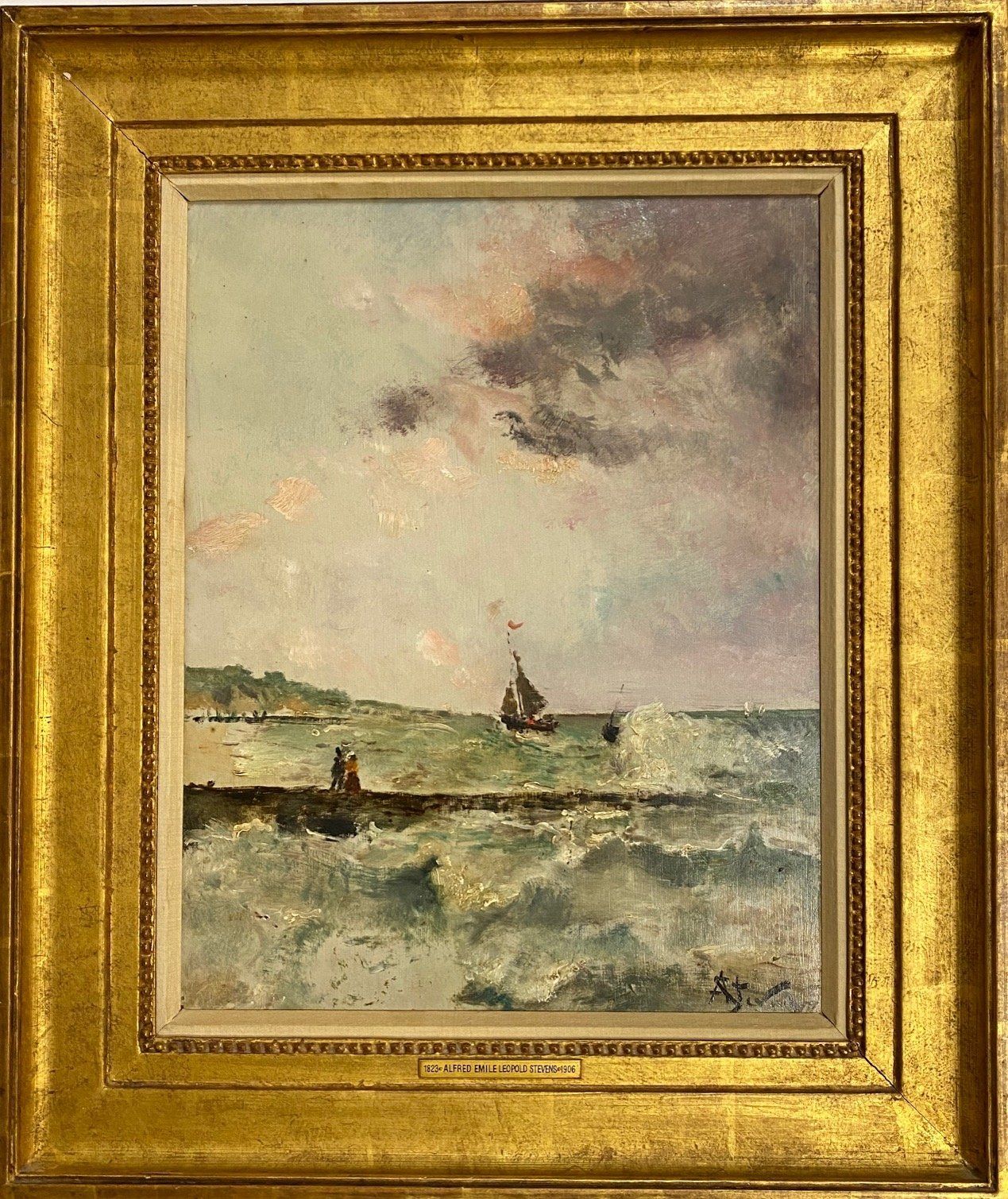Alfred Emile Leopold Stevens
Alfred Emile Leopold Stevens
(1823-1906)
Whistler's friend, the French décadent Count de Montesquiou praised Alfred Stevens, after his death, as equal to Vermeer. Stevens, who chronicled the fashionable elegance of women's sitting rooms during the Second Empire and beyond, influenced American expatriate painters, and there are close affinities to the Boston School.
Alfred Stevens, born in Brussels on 11 May 1823, was a student of François-Joseph Navez (1787-1869), Belgium's most important pupil of Jacques-Louis David; then in 1844 Stevens continued his studies under Camille Roqueplan (1803-1855) in Paris, whose looser, more casual technique pleased public taste (Harambourg, 1985, p. 304). After 1852, Stevens remained in Paris indefinitely; his earliest works show various influences, from Courbet, Couture, and Velázquez. His Paris debut was at the Salon of 1853 where his Ash-Wednesday Morning was purchased by the French government (Musée des Beaux-Arts, Marseille).
Stevens quickly became an important part of the Paris cultural scene, socializing with Delacroix, Théodore Rousseau, Alexandre Dumas, Baudelaire, and Edouard Manet. He was part of the latter's circle at the Café Guerbois. Already in 1863, the year of the Salon des Refusés, Stevens was named Chevalier of the Legion of Honor. Stevens was the link between Manet and Paul Durand-Ruel, who bought over twenty of Manet's canvases in 1871.
During the following decade, Stevens lived in a splendid house on the rue des Martyres, which had a vast English garden; he frequented the Café Tortoni and the Café Riche, and began teaching. His house and studio were sumptuously furnished with period furniture, Oriental carpets and porcelains, an eclectic array of paintings, luxurious fabrics and tapestries, producing a "highly personal, warm, colorful, and intimate effect. In such an ambiance, he received writers, painters, musicians and theater people." (Coles, 1977, p. xvi).
During the 1880s, Stevens organized a special atelier for women painters on the avenue Frochot. One of his pupils was Lilla Cabot Perry (May 1889). Remaining faithful to Manet to the very end, Stevens served as a pallbearer at his funeral in 1883 and helped to organize the memorial exhibition a year later. Although supportive of Manet, Stevens could not accept Seurat's neo-impressionism, if we believe Signac (quoted by Rewald, 1946, p. 29); Signac told how Stevens would bring in groups of friends from the Café Tortoni to the last group show of the impressionists to hurl abuse at Seurat's Sunday Afternoon on the Island of La Grande Jatte (Art Institute of Chicago). In 1889, with the help of assistants, Stevens painted the Panorama of the Century (120 meters wide; dismantled), exhibited at the Universal Exposition of that year.
In the late period Stevens developed a bronchial condition, suffered a rejection by the Brussels Museum after applying for its position of director, and experienced financial troubles. William Rothenstein (1931, p. 59) described "poor Stevens" in his later years: "Alfred Stevens, a magnificent old ruin, broad-shouldered, white-haired, with a fine head and a powerful frame still erect in spite of his years. . . . Poor Alfred Stevens! He had been one of the great figures of the Second Empire; all the great ladies of that glittering period had passed through his studio. A great lover of women, he had lived splendidly, earned largely; he had been wildly extravagant and although he had once owned a whole street, he was now reduced to living in a modest atelier and a couple of rooms. . . . Still, everyone treated 'le Père Stevens' with great respect, for not only had he been a great figure, but he had been a great painter as well."
Coles (1977) has studied the influence Stevens had on American painters, including William Paxton, whose subject matter is close to that of the Belgian painter. Paxton's painting, The New Necklace (Museum of Fine Arts, Boston) immediately recalls Stevens. Paxton may have seen A Passionate Song by Stevens in the Palace of Compiègne, which features similar precise drawing, crisply defined fabrics, and luxurious accessories. Paxton's work entitled 1875 (Private collection), which features a woman in a green satin dress, was compared to Stevens when the painting was exhibited at the Art Institute of Chicago in 1916: "No one, save Alfred Stevens, has ever made close studies of feminine apparel so utterly fascinating." (Fine Arts Journal, December 1916).
Philip Hale was interested enough in Stevens to write a monograph on the Belgian artist in 1910. Dennis Miller Bunker's painting Reading Aloud of 1886 (Private collection) has traditionally been related to Alfred Stevens. Gammell (1953, pp. 49-50) suggests that Bunker must have had original canvases by Stevens on hand.
Apparently, Stevens and Whistler admired each other. According to letters, William Merritt Chase accompanied Whistler to an international art exhibition in Antwerp where Whistler gave a rare bit of praise to one of Stevens's paintings (Roof, 1917, p. 135). Rothenstein (1931, p. 60) wrote how Stevens was "the first French painter whom I heard give high praise to Whistler." Both Whistler and Stevens were enthused over the movement known as Japonisme. In the 1860s, the two painters used Japanese motifs essentially to the same degree. Whistler's La princesse du pays de la porcelaine (Freer Gallery of Art, Washington, DC) has the same effect of The Blue Dress by Stevens (Sterling and Francine Clark Art Institute). In both, Japanese objects (Chinese in the case of Whistler) are merely decorative accessories.
William Merritt Chase seems to have had the closest affinities to the Belgian painter. Stevens and Chase met in 1881 when the former praised Chase's Portrait of Frank Duveneck or The Smoker (destroyed), however he cautioned the American artist not to force an "old master" look onto his paintings (Roof, 1917, p. 95). Immediately, Chase lightened his palette and gradually moved from the dark Munich style. And Chase seems to have been imitating Stevens in the decoration of his spacious Tenth Street Studio. He purchased several works by Stevens, who influenced the American painter in a general manner. Oil sketches by Stevens, such as The Young Woman, painted for Manet in 1868 (National Gallery of Ireland, Dublin), represents the most casual, personal side of Stevens's art. His late seascapes approximate the spirit of impressionism in their spontaneity and rapid drawing with the brush. In his Impressions on Painting, Stevens wrote, "We must be of our own time," and "One should learn to draw with the brush as soon as possible." He was, in his own way, a painter of his day.
On 24 August 1906, Stevens passed away, a month before the death of Cézanne. Paris was already a hotbed of modernism; the bold, brightly painted canvases of the Fauves and German Expressionists show a total rejection of the Second Empire, genteel imagery of painters like Stevens.
Alfred Stevens, born in Brussels on 11 May 1823, was a student of François-Joseph Navez (1787-1869), Belgium's most important pupil of Jacques-Louis David; then in 1844 Stevens continued his studies under Camille Roqueplan (1803-1855) in Paris, whose looser, more casual technique pleased public taste (Harambourg, 1985, p. 304). After 1852, Stevens remained in Paris indefinitely; his earliest works show various influences, from Courbet, Couture, and Velázquez. His Paris debut was at the Salon of 1853 where his Ash-Wednesday Morning was purchased by the French government (Musée des Beaux-Arts, Marseille).
Stevens quickly became an important part of the Paris cultural scene, socializing with Delacroix, Théodore Rousseau, Alexandre Dumas, Baudelaire, and Edouard Manet. He was part of the latter's circle at the Café Guerbois. Already in 1863, the year of the Salon des Refusés, Stevens was named Chevalier of the Legion of Honor. Stevens was the link between Manet and Paul Durand-Ruel, who bought over twenty of Manet's canvases in 1871.
During the following decade, Stevens lived in a splendid house on the rue des Martyres, which had a vast English garden; he frequented the Café Tortoni and the Café Riche, and began teaching. His house and studio were sumptuously furnished with period furniture, Oriental carpets and porcelains, an eclectic array of paintings, luxurious fabrics and tapestries, producing a "highly personal, warm, colorful, and intimate effect. In such an ambiance, he received writers, painters, musicians and theater people." (Coles, 1977, p. xvi).
During the 1880s, Stevens organized a special atelier for women painters on the avenue Frochot. One of his pupils was Lilla Cabot Perry (May 1889). Remaining faithful to Manet to the very end, Stevens served as a pallbearer at his funeral in 1883 and helped to organize the memorial exhibition a year later. Although supportive of Manet, Stevens could not accept Seurat's neo-impressionism, if we believe Signac (quoted by Rewald, 1946, p. 29); Signac told how Stevens would bring in groups of friends from the Café Tortoni to the last group show of the impressionists to hurl abuse at Seurat's Sunday Afternoon on the Island of La Grande Jatte (Art Institute of Chicago). In 1889, with the help of assistants, Stevens painted the Panorama of the Century (120 meters wide; dismantled), exhibited at the Universal Exposition of that year.
In the late period Stevens developed a bronchial condition, suffered a rejection by the Brussels Museum after applying for its position of director, and experienced financial troubles. William Rothenstein (1931, p. 59) described "poor Stevens" in his later years: "Alfred Stevens, a magnificent old ruin, broad-shouldered, white-haired, with a fine head and a powerful frame still erect in spite of his years. . . . Poor Alfred Stevens! He had been one of the great figures of the Second Empire; all the great ladies of that glittering period had passed through his studio. A great lover of women, he had lived splendidly, earned largely; he had been wildly extravagant and although he had once owned a whole street, he was now reduced to living in a modest atelier and a couple of rooms. . . . Still, everyone treated 'le Père Stevens' with great respect, for not only had he been a great figure, but he had been a great painter as well."
Coles (1977) has studied the influence Stevens had on American painters, including William Paxton, whose subject matter is close to that of the Belgian painter. Paxton's painting, The New Necklace (Museum of Fine Arts, Boston) immediately recalls Stevens. Paxton may have seen A Passionate Song by Stevens in the Palace of Compiègne, which features similar precise drawing, crisply defined fabrics, and luxurious accessories. Paxton's work entitled 1875 (Private collection), which features a woman in a green satin dress, was compared to Stevens when the painting was exhibited at the Art Institute of Chicago in 1916: "No one, save Alfred Stevens, has ever made close studies of feminine apparel so utterly fascinating." (Fine Arts Journal, December 1916).
Philip Hale was interested enough in Stevens to write a monograph on the Belgian artist in 1910. Dennis Miller Bunker's painting Reading Aloud of 1886 (Private collection) has traditionally been related to Alfred Stevens. Gammell (1953, pp. 49-50) suggests that Bunker must have had original canvases by Stevens on hand.
Apparently, Stevens and Whistler admired each other. According to letters, William Merritt Chase accompanied Whistler to an international art exhibition in Antwerp where Whistler gave a rare bit of praise to one of Stevens's paintings (Roof, 1917, p. 135). Rothenstein (1931, p. 60) wrote how Stevens was "the first French painter whom I heard give high praise to Whistler." Both Whistler and Stevens were enthused over the movement known as Japonisme. In the 1860s, the two painters used Japanese motifs essentially to the same degree. Whistler's La princesse du pays de la porcelaine (Freer Gallery of Art, Washington, DC) has the same effect of The Blue Dress by Stevens (Sterling and Francine Clark Art Institute). In both, Japanese objects (Chinese in the case of Whistler) are merely decorative accessories.
William Merritt Chase seems to have had the closest affinities to the Belgian painter. Stevens and Chase met in 1881 when the former praised Chase's Portrait of Frank Duveneck or The Smoker (destroyed), however he cautioned the American artist not to force an "old master" look onto his paintings (Roof, 1917, p. 95). Immediately, Chase lightened his palette and gradually moved from the dark Munich style. And Chase seems to have been imitating Stevens in the decoration of his spacious Tenth Street Studio. He purchased several works by Stevens, who influenced the American painter in a general manner. Oil sketches by Stevens, such as The Young Woman, painted for Manet in 1868 (National Gallery of Ireland, Dublin), represents the most casual, personal side of Stevens's art. His late seascapes approximate the spirit of impressionism in their spontaneity and rapid drawing with the brush. In his Impressions on Painting, Stevens wrote, "We must be of our own time," and "One should learn to draw with the brush as soon as possible." He was, in his own way, a painter of his day.
On 24 August 1906, Stevens passed away, a month before the death of Cézanne. Paris was already a hotbed of modernism; the bold, brightly painted canvases of the Fauves and German Expressionists show a total rejection of the Second Empire, genteel imagery of painters like Stevens.
Courtesy of AskArt.com




